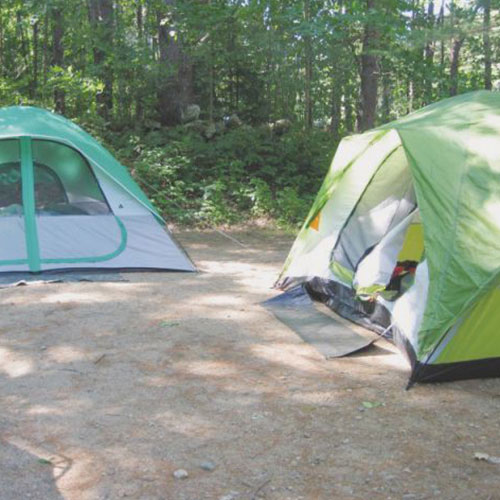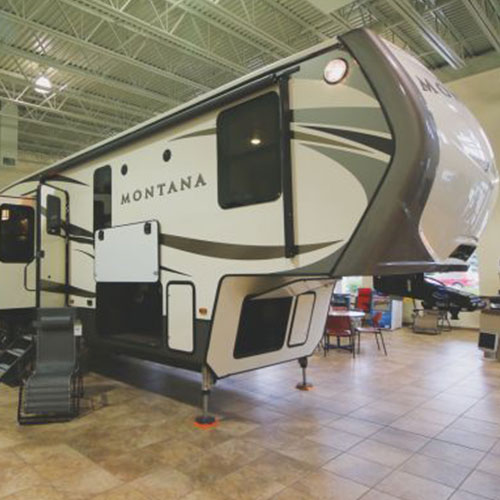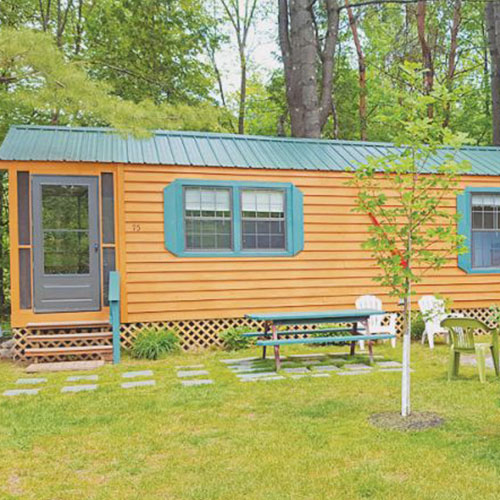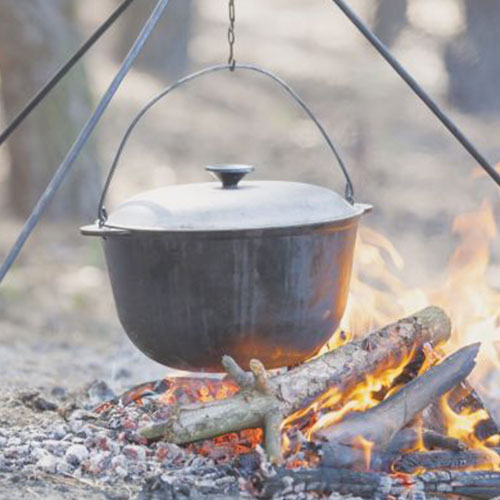FEATURED POP - * COVER STORIES *
Tent Out
Tent Out
The Essentials of Tent Camping
Written By Matt Ingersol (listings@hippopress.com)
Images: Courtesy Photo
Local campground owners and seasoned campers say tent camping is the best way to get the most out of the outdoors — and it can be pretty enjoyable if you’re properly prepared.
Tents come in all kinds of different sizes and types, including dome tents, ridge tents and tunnel tents. Some have their own built-in features like screens to put up to keep mosquitoes out.
“If you’re looking to get a tent long-term, you need to make sure you’re able to stand up and get dressed in it comfortably,” said Ellen Bagley, co-owner of Autumn Hills Campground in Weare. “Tarps are also pretty much a necessity too, because you can use it to prevent the tent from getting wet if it rains.”

Bagley said sporting goods stores like Dick’s and Eastern Mountain Sports are always great sources for tents, but even department stores like Wal-Mart have their own extensive collections.
Jessica Byrnes, a seasoned tent camper of more than 25 years and whose father is a member of the Epsom-based New Hampshire Campground Owners Association, said tents can range anywhere from $50 to $800, depending on quality and size.
What you use to sleep inside the tent can include anything from sleeping bags to foam mats or even air mattresses if you have air pumps, Bagley said.
“The thing about air mattresses to keep it mind is that if the weather is cool, sometimes it will actually feel colder on the air mattress than on the ground itself,” she said. “So that’s when you could use a warm comforter with it.”
And since tents don’t have the temperature-controlled luxury of RVs or cabins, proper clothing is essential.
“For camping around Memorial Day weekend or Columbus Day weekend, it could always get hotter or colder than you might expect, so I’d usually pack clothes for all four seasons,” Byrnes said.
Footwear is important too, especially at tent sites where the terrain is likely a little rough. Bagley recommends making sure you bring at least one pair of a sturdy type of footwear, like laced sneakers or hiking boots, not just flip-flops or sandals.
“Around the campfire is one thing, but otherwise, you don’t want to constantly leave your feet open for rocky and gravel surfaces, or for walking up and down a hill. You’d want something a little safer underfoot,” she said.
When you’re setting up your tent, be sure to consider its location.
“Fire is always a big safety hazard, so it’s important to remember not to set up your tent too close to your fire pit so it doesn’t catch fire, and also if you have little kids, to make sure they’re not walking or sitting too close to the fire,” she said.
To prevent the attraction of wild animals to your campsite, make sure you never leave food unattended and that it is stored properly.
“In New Hampshire, we’ll get everything ... from bobcats and fisher cats to bears and moose,” Bagley said. “Tent campers need to always be vigilant and to not leave their trash out, or feed the animals, because they will come back. … Aluminum foil and zip-lock bags are also great tools to store food in your car, as well as double-duty things like Tupperware containers.”
Bagley said Leatherman tools are useful, not only for cooking and food preparation but for propping your tent as well. Most tools can convert to be used as knives, can openers, hammers and other useful tools.
The key to getting the most out of tent camping is to remember not to let the unexpected spoil the fun.
“It doesn’t have to be as uncomfortable as some people may think, because you can do so much with so little,” Bagley said, “and if you forget something, you shouldn’t let that ruin your weekend. … Taking what you have and improvising with it is important.”
Home Away from Home
Home Away From Home
The Best Way to Go Glamping
Written By Ryan Lessard (news@hippopress.com)
Images: Courtesy Photo
With recreational vehicles, or RVs, campers can set up all the amenities of home at a camp site.
Basic vs. Luxury
Howard “BJ” Hallett has been a salesman at Camping World of New Hampshire in Chichester for 12 years. He said the most popular types of RVs are travel trailers.
“They tend to be bunk houses because it’s a family vacation kind of thing,” Hallett said.
Travel trailers are the most basic boxy camper that is towed by another vehicle. On the small side, they can be 15 to 16 feet long, Hallett said. If they’re being towed somewhat regularly, the larger sizes tend to be 35 to 36 feet. If they’re meant to be stationary at a permanent location, they’re more likely to reach up to 40 feet in length.
The next most popular are “fifth wheel” trailers, which are identified by their front extension that slopes prominently over a flatbed hitch, followed by motorhomes, which are RVs where the automobile and the camper are one and the same.

The motorhomes are divided into classes A, B and C. The Class A motorhomes are the large bus-style vehicles. They are made with gas and diesel engines, but Hallett said the diesel pusher models are the least popular because they’re more expensive and less cost-effective to maintain.
The Class B “looks like a conversion van with a raised roof,” but Hallett said the smaller Class C motorhomes are the most popular, in part because they are less difficult to drive.
“They feel more comfortable in a smaller cockpit of the van style with the body on the back versus the Class A with the big monster windshield in front of them,” Hallett said.
On the smaller end, the most common size for Class C motorhomes is about 24 to 25 feet long. Most standard Class Cs are built on a Ford E-450 chassis, which can go up to about 32 feet. Class A motorhomes can range in size from 26 to 38 feet, according to Hallett, and diesel pushers range from 34 to 45 feet on average.
Buying vs. Renting
Hallett said the average customer pays about $200 to $300 per month for a new financed camper. On the high end, he calculates customers would be paying somewhere around $910 per month on his most popular high-end model, the A.C.E. Motorhome by Thor Motor Coach. That’s assuming a customer puts 10 percent down on the $141,000 vehicle with an interest rate of about 5.99 percent.
Buying an RV is like buying a home in the sense that one needs to account for things like appliance maintenance and utility costs on top of the regular finance payments. But when it comes to the investment, it’s more like a car, which reliably depreciates in value.
“If you buy something for $100[K], you could go to trade it the next day, it’s worth about 70 to 75 thousand,” Hallett said.
Some people prefer to rent campers, often as a way of testing the waters and seeing if they like it enough to buy one. For others, it’s a simple matter of not having a place to store a camper. Carl Sylvester, the owner of Northeast RV Rentals in Northwood, said it can cost anywhere from $95 per night for a pop-up trailer to $295 per night for a luxury Class C motorhome. Some smaller trailers that can be towed by motorcycles can cost as little as $50 per night.
For motorhomes, Sylvester said it costs 45 cents per mile for every mile over 100.
Home Away from Home
Kelly Wood, the property manager at Sandy Beach RV Resort in Contoocook, calls camping in an RV “glamping,” a portmanteau of glamorous camping, because RVs provide almost all the amenities of home.
“A camper is a minihome, ultimately,” Wood said. “Everything is inside of your camper that you could possibly need.”
Hallett said most Class C motorhomes include standard amenities like a kitchen, a bathroom, a cable hookup for a TV and connections for electricity, water and sewage.
Some campsites, including Wood’s, offer all those connections at their RV spots, but some parks have dump stations for sewage on the way out of the park.
The quality of the features varies based on the model. For instance, all RVs come with a basic kitchen, but higher-end models come with Corian countertops instead of the typical Formica, stainless steel appliances and, while all provide a space for a TV, pricier models come with the TV already installed.
Better models have porcelain toilet bowls, compared to plastic toilet bowls, or medicine cabinet mirrors rather than just a mirror. They all come with a shower but upscale models replace shower curtains with Plexiglass doors.
All models generally have air conditioning and a water heater. Mattress sizes vary in RVs and the more high-end motorhomes will have more comfortable pillowtop mattresses or memory foam mattresses that keep sleepers cool by maintaining air flow.
Under Cover
Under Cover
Cabins Offer a More Laid Back Experience
Written By Angie Sykeny (asykeny@hippopress.com)
Images: Courtesy Photo
If you’re new to camping or looking for a more relaxed camping experience, cabin camping may be a good option. Some cabins provide only shelter while others provide all the modern comforts of home, so you can choose your preferred level of roughing it.
For the full camping experience minus the tent, there are rustic cabins, which may include a few essentials or may be nothing more than a roof over your head. Friendly Beaver Campground in New Boston is one local campground that offers rustic cabins; each cabin consists of a single room with a closet, a queen bed and two sets of bunk beds, a small table and chairs, and minimal electricity for lighting and a ceiling fan. A charcoal grill and fire ring are provided outside for cooking, and there’s a public bathroom a short walk away.
“The term is ‘rustic’ because it’s supposed to be very rustic and in nature. It’s not like a hotel,” Friendly Beaver Manager Robert Charest said. “It’s just a different type of shelter for people who don’t like to sleep on the ground, but outside of that, there is no difference [from traditional camping].”

At Exeter Elms Family Campground in Exeter, campers have a choice between a rustic cabin and a full cabin, which includes beds, a bathroom and a working kitchen equipped with a refrigerator, stove, oven, microwave, toaster and coffeemaker.
“The rustic cabin is just four wooden walls and a roof, so it’s basically like camping in a giant tent, only if it rains, you won’t get soaked,” Exeter Elms office manager Robin Falef said. “The full cabins are for people who don’t want to do regular camping. They want all the bells and whistles and luxuries of home.”
Some campgrounds have full cabins with even more amenities. The cabins at Silver Lake Park Campground & Cabins in Belmont, for example, include everything the Exeter Elms cabins have, plus a living room area, HDTV, internet access and climate control.
These kinds of cabins are typically used as a more outdoors-centric alternative to a hotel for people who travel to the area for a particular attraction. (Campers at Exeter Elms often spend their days at Hampton Beach while Silver Lake Park campers are often there to vacation at the lake.) Falef said they are not a good fit for people seeking an intentional and authentic camping experience, and that people should be wary of how the term “camping” is used nowadays.
“Unfortunately, camping doesn’t mean what it used to,” she said. “Camping [at the full cabins] isn’t really camping. Real camping is about roughing it.”
Cabin camping can, however, be a good option for first-time campers and people who want to get a taste of the experience before investing the time and money needed for a more bare-bones camping trip.
“We get all these calls from people who want to try camping but are too nervous because they don’t know how to pitch a tent and do all this camping stuff,” Silver Lake Park campground manager Ashley Jaynes said. “This is a way for them to try camping on their own while still having the luxuries they’re used to.”
Cabin camping can also be a way for people and families with mixed enthusiasm about the outdoors to experience some of the fun that camping has to offer without being cut off from the outside world. Between lake activities like swimming, fishing, boating, canoeing and kayaking; hiking the surrounding trails and hanging out around the campfire, Jaynes said, most campers at Silver Lake Park find themselves spending very little time using the television and internet anyway.
“There may be people who won’t go camping because they don’t want spiders or don’t want to use a public bathroom, or because they have to have their smartphones,” Jaynes said. “I wish they knew that there is a more modern way of camping where they can still check in with their smartphones and post a photo to Facebook and have all these amenities. Then, they might give camping a chance.”
Beyond Hot Dogs
Ideas for Cooking over a Fire
Written By Kelly Sennott (ksennott@hippopress.com)
Images: Stock Photo
Cooking over a campfire doesn’t have to be as basic as holding marshmallows on a stick over the flames. The next time you go camping, consider making fancier treats, or even a whole meal.
Start the Fire
Starting the right kind of fire is the most important thing, said Heidi Holman, a biologist with New Hampshire Fish and Game who also teaches workshops with Becoming an Outdoors-Woman. But it’s not always easy.
“Too often, people start with fuel that’s too big, so they get frustrated because the fire goes out and the fuel hasn’t caught. You want to start with a lot of tinder — dry leaves, grass, really small twigs. Some people bring dryer lint from home,” Holman said.

Next, layer on pine needles, then small twigs followed by larger twigs. Eventually, you’ll have enough flame to add larger pieces of wood. Holman estimated it will take at least 15 minutes of solid activity before the fire creates coals ready to cook with.
The food you’re cooking and how you’re cooking it will determine the kind of fire you want. If you’re using a Dutch oven, for instance, you’ll probably simmer over a flame, not coals. The size of the party matters, too.
“When we teach this [outdoor cooking] class, we do a large fire because there are 15 people. But if it’s just you and maybe your kids, you’ll want to have it in a contained area so the fire doesn’t spread,” Holman said.
Food on a Stick
Feeling lazy? Put a hot dog on a stick. Done. But you can also jazz that up easily; before you cook the hot dog, cut each end partway before placing it over the fire. As you cook, the sliced ends will curl, resembling spider legs.
Tara Pacht, vice president of the Girl Scouts of the Green and White Mountains board, said one of the challenges at a workshop she taught was to cook an egg on a stick; very carefully stick a skewer through a raw egg, then roast it over the fire like a marshmallow.
And of course, camping isn’t camping without a s’more, and there are a zillion ways to vamp up yours. (Fun fact: the Girl Scouts originated the recipe, published in Tramping and Trailing with the Girl Scouts in 1927.) Pacht advised trying it with Nutella instead of a Hershey bar or cookies instead of graham crackers. Or melt your chocolate at the same time as your mallow by slicing a pocket and plopping the chocolate square inside. You could also replace your marshmallow with a strawberry covered in fluff or a Peeps marshmallow.
Foil Packs
This is probably the next-easiest cooking method with the fastest cleanup. Pacht likes foil packs because they allow you to individualize the meal for each camper. Fill them with meat, veggies and potatoes for a “hobo stew packet” (slicing potatoes very thin, and choosing vegetables with lots of moisture, which will help the potatoes steam). Double-wrap them with heavy-duty foil and keep them small enough to cook fully, particularly if they contain meat. (If you use lightweight or inexpensive foil, it’s possible the foil will deteriorate, said Holman.) Place them on coals, not flames, and check regularly. Another idea, courtesy of Pacht: cut a spaghetti squash in half, fill with ground beef and tomato sauce, wrap in foil, and voila — spaghetti and meatballs.
Dutch Oven and Pie Irons
Dutch ovens kind of look like witches’ cauldrons and work best either sitting on a bed of coals or hanging over the fire on a tripod. Pacht said she made a killer spinach cheese dip with a Dutch oven teaching a recent workshop with Girl Scout volunteers, combining fresh spinach, a variety of cheeses, sour cream and artichokes. You can tackle spaghetti with these, too; throw in some dry pasta, water and tomato sauce, and it’s a one-pot meal. You can even bake cookies in a Dutch oven.
But Pacht’s favorite outdoor cooking gadget is the pie iron, which is kind of like an enclosed skillet attached to a stick you place in the fire. Fill it with buttered bread and cheese for an epic grilled cheese, rotating part-way through, or bake a pie by inserting pre-made crust and fruit filling inside. Most any kind of sandwich melt will work with these, but if you want to mix it up, use phyllo dough instead of bread and make a caprese (mozzarella, tomato, basil) or make it sweet with brie, apples and honey. The pie iron is also perfect for pizza with premade crust.
More Tips
Rookies: keep an eye on the fire, and season your cast iron equipment before using. To save time on washing dishes afterward, Pacht recommends spreading a layer of soap on the outside of your pans to keep soot from sticking. After that, the options are endless. All it takes is some creativity.
“If I can cook it at home, I can cook it in the woods with some modifications,” Pacht said. “We think about what we ate at the house and how we can modify that recipe for the ease and creativity of camping. … Google ‘creative campfire cooking’ or ‘fun outdoor camp cooking’ and you can get some fabulous ideas. … It’s a very social activity. When somebody’s cooking at home, it might be one or two people, but this engages everybody.”
